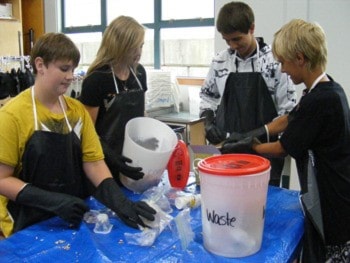Lake Cowichan Secondary School is cutting down its carbon footprint in a very big way.
Last year, the school averaged about 15 full garbage bags of waste per day.
Only one week into a brand new school-wide recycling program, they’re now down to an average of under one bag per day.
“I have been so pleased,” teacher Michelle Taylor said. “They’re doing a fantastic job.”
Taylor is heading the Grade 6 to 8 project, which is a simple but extremely effective one.
All garbage cans in the school have been replaced by smaller bins; one for organic waste and the other meant for refuse destined for a landfill.
Every day after lunch, a group of students collect the bins and organizes them.
Students transport the organic waste into a three-bin compost area that has been constructed at the school.
The over-arching program is called STAR(4)C Raving Mad for the Environment.
The acronym stands for Students Taking Action by Recycling, Reducing, Reusing, and Refusing, and Composting.
It’s an important lesson to teach the students, Taylor said, in that most things that have gone into the landfill have been recyclable.
“It’s never too late to start thinking about the environment,” Taylor said, adding that the sooner people take care of the environment the better.
Students’ being proactive with regard to recycling is a lot more effective than simply reading about it, she added.
The program was sparked by a $12,000 Neighbourhood of Learning grant the school received, as a result of a partnership between the school district and the Town of Lake Cowichan.
This grant has helped pay for greenhouse upgrades, with Mr. Pimenta and his Grade 10/11 shops classes making vast improvements upon the previously dilapidated structure.
The greenhouse should see fruit and vegetables planted somem time in the spring.
The same applies to a community garden area, which will also be operational by spring.
“It’s all ready to go, and the soil will be added in February or March,” Taylor said.
One community garden box will be maintained by students, and will help supplement the school’s lunch program. The remaining garden boxes will be open for members of the public to take care of.
Only a week in, Taylor said that the program has been a resounding success.
Students’ knowledge of recycling will be further broadened this semester by three environmental workshops by the Nanaimo Recycling Exchange.
